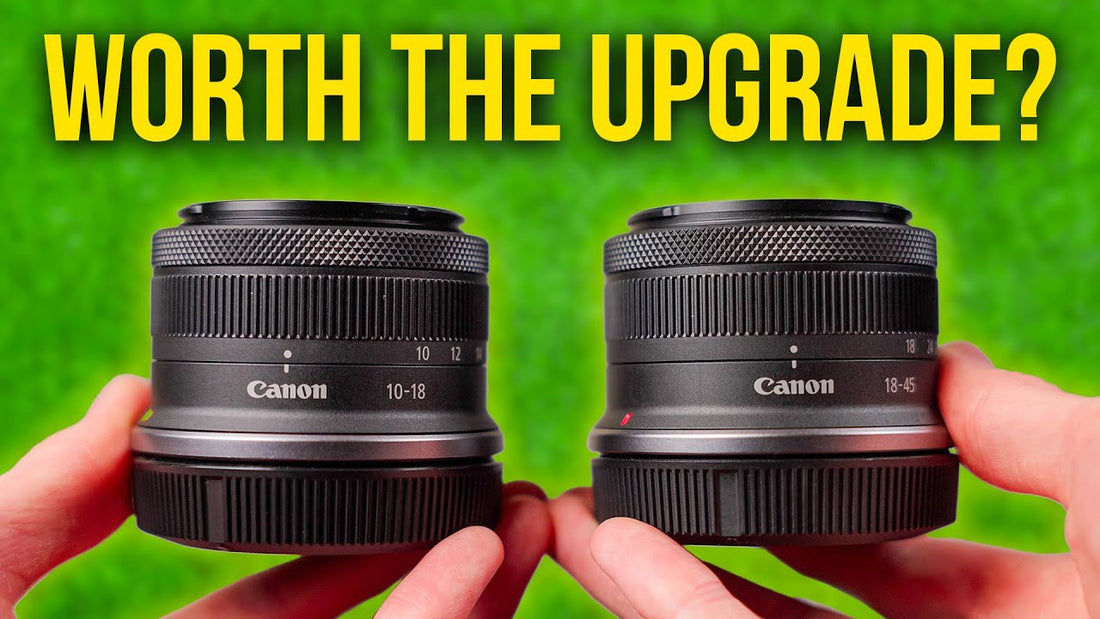
Canon RF-S 10-18mm vs 18-45mm Kit Lens | Is It Worth The Upgrade?
Check out my full video HERE
This post contains affiliate links. If you click and make a purchase, I may earn a commission at no extra cost to you. Thanks for your support!
Introduction
The Canon R50, R10, and other APS-C RF-mount cameras often come bundled with the 18-45mm kit lens. But Canon recently released a new ultra-wide RF-S 10-18mm, offering a far wider perspective in a package that looks surprisingly similar. Both lenses are small, stabilized, and budget-friendly—but which one is better, and is the 10-18mm worth the upgrade?
Below, we’ll compare these two lenses in terms of build, handling, focal range, and image quality to help you decide.
Physical Comparison
Size & Weight
-
RF-S 18-45mm:
- Slightly larger when extended, yet lighter at about 4.6 oz.
-
RF-S 10-18mm:
- More compact when shooting, but slightly heavier at around 5.3 oz.
Both are collapsible zoom designs that lock into “storage” or “usable” positions, but in practice, you’ll barely notice the weight difference.
Controls & Aperture
- Both have a single ring that can be set to focus or serve as a custom control.
- Neither features an external stabilization switch or AF/MF toggle; you’ll need to change those settings via the camera menu.
- Aperture range on both is f/4.5-6.3, meaning they’re relatively slow lenses, especially at the telephoto end, but that’s the trade-off for ultra-compact size and low cost.
Stabilization & Autofocus
- Optical IS: Both include 4 stops of built-in stabilization—a huge plus for handheld shooting and cameras without IBIS (e.g., R10, R100, R50).
- AF Performance: Extremely fast and silent on both. The newer 10-18mm may be marginally quicker, but in real-world use, both do well.
Focal Range & Close Focus
-
RF-S 18-45mm:
- Effective 29-72mm full-frame equivalent—ideal for general use, walk-around, or simple portraiture.
- Minimum focus is about 7.9 inches.
-
RF-S 10-18mm:
- Effective 16-29mm full-frame equivalent—an ultra-wide perspective for vlogs, interiors, architecture, and sweeping landscapes.
- Minimum focus is listed at 5.5 inches, but in manual focus mode at 10mm, it can achieve near-macro distances (practically right against the front element!). This is a major advantage for creative, wide-angle close-ups.
Image Quality Comparison
To see how they fare side by side, we compare at 18mm:
-
Center Sharpness:
- 18-45mm can be slightly sharper wide open in the very center compared to the 10-18mm (which is at f/6.3 at 18mm).
- However, the difference is minor and often negligible in real shooting.
-
Corner Sharpness & Vignetting:
- 10-18mm typically exhibits less vignetting and sharper corners at 18mm compared to 18-45mm.
- The 18-45mm corners can be darker and softer, though stopping down (e.g., f/8) helps reduce vignetting.
Verdict on IQ:
Overall, the 10-18mm performs better at the edges, with less vignetting and sharper corners. The 18-45mm is decently sharp in the center but shows more edge drop-off.
Which Should You Choose?
RF-S 18-45mm (Kit Lens)
-
Pros:
- Good all-around range for everyday shooting.
- Inexpensive when bundled; lightest possible kit lens.
- Fine center sharpness wide open.
-
Cons:
- Not ultra-wide for vlogging/landscapes.
- Softer corners and heavier vignetting at 18mm.
RF-S 10-18mm (Ultra-Wide Upgrade)
-
Pros:
- Significantly wider coverage: 10-18mm is perfect for vlogs, group shots, interiors, architecture.
- Great corner sharpness and less vignetting at 18mm.
- Fun near-macro focusing at 10mm in manual focus.
-
Cons:
- Aperture is still f/4.5-6.3, so not great in low light.
- Doesn’t replace a “general purpose” focal range if you need mid or tele coverage.
Final Thoughts
If you’ve ever felt limited by the kit lens’s 18mm, the RF-S 10-18mm could be the best budget-friendly solution. Its ultra-wide focal range transforms small spaces and scenic vistas, plus delivers sharper corners with less vignetting. The near-macro focusing at 10mm is a bonus for creative close-ups. However, it won’t cover the standard range above 18mm, so it’s not a full replacement for the kit lens—more an addition to your kit if you crave wide perspectives.
In short: If you regularly shoot landscapes, architecture, or want to vlog with the widest possible angle on Canon’s APS-C RF cameras, the 10-18mm lens is absolutely worth the upgrade.
